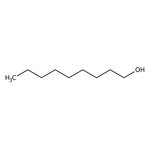Search Thermo Fisher Scientific
Thermo Scientific Chemicals
1-Nonanol, 99%
CAS: 143-08-8 | C9H20O | 144.258 g/mol
| Catalog Number | Quantity |
|---|---|
| ALFA12510.22 | 100 g |
Catalog number ALFA12510.22
View Price:Sign InSign in to see your account pricing. Need an account? Register with us today.
Quantity:
100 g
Specifications
Chemical Name or Material1-Nonanol
CAS143-08-8
Health Hazard 1H227-H315-H319-H332-H335
Health Hazard 2GHS H Statement
H332-H319-H227
Harmful if inhaled.
Causes serious eye irritation.
Combustible liquid.
H332-H319-H227
Harmful if inhaled.
Causes serious eye irritation.
Combustible liquid.
Health Hazard 3P210-P261-P264b-P271-P280-P302+P352-P304+P340-P305+P351+P338-P312-P332+P313-P362-P370+P378q-P501c
View more
The primary use of nonanol is in the manufacture of artificial lemon oil. 1-Nonanol is mainly used in man-made rose essence, plasticizer, surfactant. 1-Nonanol was used as a reference material in the determination of airborne spore levels. 1-Nonanol inhibited the bacterial luciferase (BL) reaction in a dose-dependent manner.
This Thermo Scientific Chemicals brand product was originally part of the Alfa Aesar product portfolio. Some documentation and label information may refer to the legacy brand. The original Alfa Aesar product / item code or SKU reference has not changed as a part of the brand transition to Thermo Scientific Chemicals.
Applications
The primary use of nonanol is in the manufacture of artificial lemon oil. 1-Nonanol is mainly used in man-made rose essence, plasticizer, surfactant. 1-Nonanol was used as a reference material in the determination of airborne spore levels. 1-Nonanol inhibited the bacterial luciferase (BL) reaction in a dose-dependent manner.
Solubility
Soluble in water (1 g/L) at 20°C, ether, ethanol, acetone, chloroform, and mineral oil.
Notes
Store at room temperature. Ensure good ventilation.
The primary use of nonanol is in the manufacture of artificial lemon oil. 1-Nonanol is mainly used in man-made rose essence, plasticizer, surfactant. 1-Nonanol was used as a reference material in the determination of airborne spore levels. 1-Nonanol inhibited the bacterial luciferase (BL) reaction in a dose-dependent manner.
Solubility
Soluble in water (1 g/L) at 20°C, ether, ethanol, acetone, chloroform, and mineral oil.
Notes
Store at room temperature. Ensure good ventilation.
RUO – Research Use Only
General References:
- Yamasaki S.; Yamada S.; Takehara K. Inhibition of electrochemically controlled bioluminescence of bacterial luciferase by n-alkyl alcohols. Anal. Sci. 2011, 27 (4),357.
- A L Sunesson et. al. Volatile metabolites produced by two fungal species cultivated on building materials.Annals of Occupational Hygiene. 1996, 40 (4),397-410.



